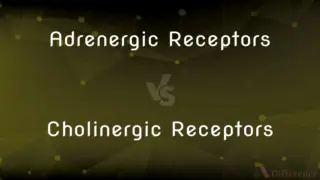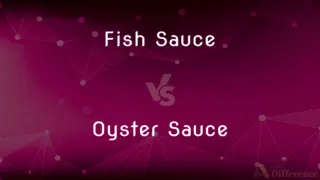Top-down Approach vs. Bottom-up Approach — What's the Difference?
By Tayyaba Rehman — Published on January 5, 2024
Top-down Approach begins with a broad overview and breaks it into smaller components, while Bottom-up Approach starts with individual elements and assembles them into a larger structure.

Difference Between Top-down Approach and Bottom-up Approach
Table of Contents
ADVERTISEMENT
Key Differences
Starting with an overall view, the Top-down Approach dissects a complex system into smaller, manageable parts. It progresses from general concepts to specific details, focusing on broader strategies before refining specifics.
Conversely, the Bottom-up Approach begins with individual elements or details, assembling them to form a complete system or structure. It emphasizes building from the ground level upwards, gradually integrating components to achieve complexity.
This approach prioritizes conceptualization, defining the entire system's architecture or strategy before diving into the specifics. It's akin to developing an outline for a project before elaborating on each section.
In contrast, the Bottom-up Approach emphasizes working on specific elements first, refining details, and gradually constructing a comprehensive system. It's similar to piecing together individual puzzle pieces to form the complete picture.
The Top-down Approach is ideal for projects requiring a strategic view, allowing for high-level planning and efficient allocation of resources based on an overarching vision.
ADVERTISEMENT
Conversely, the Bottom-up Approach suits scenarios where detailed insights into components are essential, fostering a meticulous understanding of individual elements before integrating them.
Comparison Chart
Initial Focus
Starts with a broad overview, strategy, or concept
Begins with specific elements, details, or individual parts
Progression Strategy
Moves from general to specific, breaking down complexity
Builds upwards from details, gradually forming the whole
Planning Emphasis
Emphasizes overall system architecture or strategy
Focuses on detailed components, integrating into a structure
Overview Strategy
Develops an outline or roadmap before detailed work
Constructs by combining specific elements into a larger entity
Use Case
Ideal for strategic planning and resource allocation
Suited for detailed understanding and component integratio
Compare with Definitions
Top-down Approach
Prioritizes conceptualization, breaking complexity into manageable parts.
The Top-down Approach simplifies complex projects by starting with broad concepts.
Bottom-up Approach
Emphasizes a detailed understanding before integrating into a larger system.
The Bottom-up Approach requires understanding parts before constructing the whole.
Top-down Approach
Involves planning the system's architecture before detailing individual components.
In software development, the Top-down Approach plans the software's architecture first.
Bottom-up Approach
Focuses on integrating individual elements to construct larger entities.
Using the Bottom-up Approach, engineers build systems from small components.
Top-down Approach
Efficient for allocating resources based on an overarching strategic vision.
The Top-down Approach optimizes resource allocation by planning at a strategic level.
Bottom-up Approach
Suited for scenarios requiring in-depth insights into specific components.
The Bottom-up Approach ensures a deep understanding of individual pieces before assembly.
Top-down Approach
Focuses on high-level strategies, outlining before refining specifics.
Using the Top-down Approach, architects design overall structures before detailing each part.
Bottom-up Approach
Ideal for meticulous work on individual elements before system integration.
In construction, the Bottom-up Approach focuses on each element's quality.
Top-down Approach
Begins with a general overview and later elaborates on specific components.
The Top-down Approach involves planning an outline before diving into project details.
Bottom-up Approach
Starts with specific elements, gradually forming a complete structure.
The Bottom-up Approach involves assembling parts to create the whole system.
Common Curiosities
Does it involve detailed component understanding initially?
No, it focuses on an overall view before delving into specific details.
How does it differ from the Top-down Approach in planning?
It starts with specific elements, gradually building towards a comprehensive structure.
Can it adapt well to evolving project requirements?
Yes, it offers a strategic view, making it adaptable to changing project needs.
Is it efficient for resource allocation in projects?
It requires detailed insights into components but may not be optimal for resource planning.
How does it help in project management?
It provides an overarching strategic plan, aiding in resource allocation and direction.
What kind of projects does it suit?
The Bottom-up Approach is ideal for detailed work, integrating specific elements into a larger structure.
Does it focus more on specifics or overall planning?
It starts with specifics, gradually constructing the entire system.
Does it require a detailed understanding of each component?
No, it primarily focuses on the overall system architecture initially.
How does it handle complexity?
By gradually assembling elements, it manages complexity in a systematic manner.
Is it suitable for projects needing a strategic vision?
Yes, the Top-down Approach begins with a broad strategy, ideal for strategic planning.
Is it suitable for complex project planning?
Yes, it's efficient for complex projects where individual elements need attention.
What's its role in software development?
It lays the foundation, defining the system's structure before detailed coding.
Does it provide flexibility in project execution?
Yes, it allows adjustments based on an overall strategic vision, offering flexibility.
How does it assist in system construction?
It involves meticulous attention to individual elements before integrating them into a whole.
Is it time-consuming initially?
It might take longer in the planning stage but can streamline later processes.
Share Your Discovery

Previous Comparison
Top-Down Parsing vs. Bottom-Up Parsing
Next Comparison
Gravitational Potential Energy vs. Potential EnergyAuthor Spotlight
Written by
Tayyaba RehmanTayyaba Rehman is a distinguished writer, currently serving as a primary contributor to askdifference.com. As a researcher in semantics and etymology, Tayyaba's passion for the complexity of languages and their distinctions has found a perfect home on the platform. Tayyaba delves into the intricacies of language, distinguishing between commonly confused words and phrases, thereby providing clarity for readers worldwide.















































